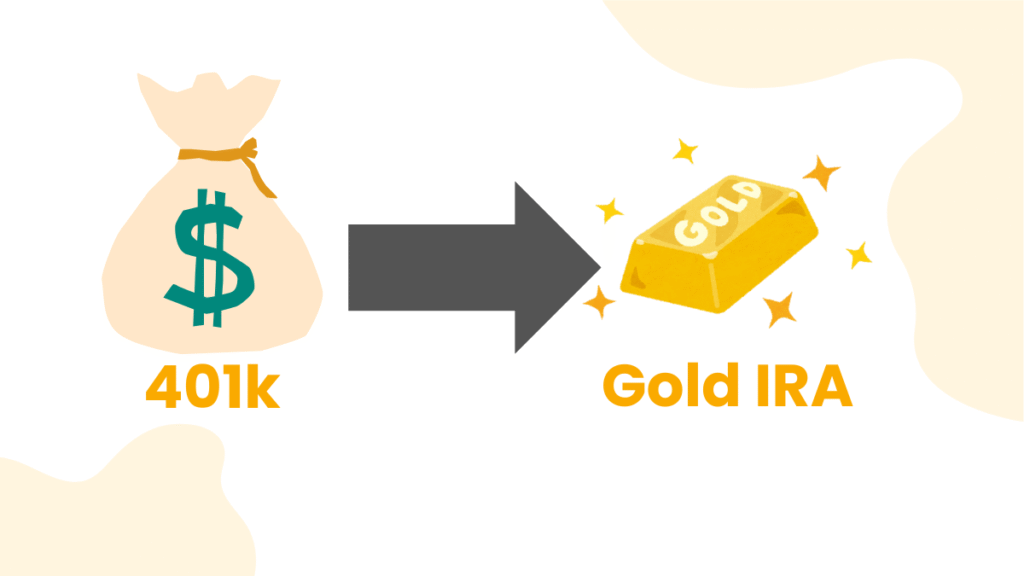Last Updated on September 2, 2025
Planning for retirement has never been more important or more challenging.
With rising inflation, volatile stock markets, and growing concerns about the U.S. dollar’s long-term stability, many Americans are looking for ways to protect their savings and preserve their purchasing power.
While traditional retirement accounts like 401(k)s and IRAs are tied heavily to paper assets such as stocks and bonds, these investments can fluctuate wildly depending on economic conditions.
That’s where a Gold IRA comes in. By holding physical precious metals – like gold, silver, platinum, and palladium, inside a self-directed retirement account, investors gain a unique hedge against inflation and market volatility.
Gold has served as a store of value for thousands of years, and in uncertain times, it often becomes the go-to safe haven for preserving wealth.
In this article, we’ll break down the key benefits of investing in a Gold IRA for retirement.
From protection against inflation and economic uncertainty to portfolio diversification and tax advantages, you’ll see why more investors are turning to gold as a strategic part of their long-term financial plan.
If you’re already curious about where to start, you can also check our list of top recommended Gold IRA companies to see which providers offer the best fees, storage options, and investor support.
Table of Contents
Understanding the Role of Gold in Retirement
For centuries, gold has been regarded as one of the most reliable stores of value.
Unlike paper currency, which can lose purchasing power due to inflation or government monetary policies, gold has historically maintained its worth across economic cycles and even during financial crises.
This unique quality makes it especially appealing for retirement planning, where the goal is to safeguard wealth over decades.
In the context of retirement, gold serves several important functions:
Wealth Preservation: Gold retains intrinsic value regardless of market trends, helping retirees protect their savings against economic downturns.
Hedge Against Inflation: As the cost of living rises, gold prices often rise with it, making gold a natural shield against inflation.
Safe Haven Asset: In times of geopolitical instability, recessions, or stock market crashes, investors tend to flock to gold, often driving up its value when other assets decline.
Diversification Tool: A retirement portfolio heavily weighted in equities or bonds is exposed to concentrated risks. Adding gold provides balance by introducing an asset that often moves independently of traditional markets.
For retirement savers, these qualities mean that gold isn’t just a shiny metal but it’s a financial tool that can anchor a portfolio against forces outside their control.
By placing physical gold into a self-directed IRA, investors ensure that a portion of their retirement wealth is insulated from market unpredictability.
Inflation Protection And Wealth Preservation
One of the most compelling reasons investors turn to a Gold IRA is its ability to safeguard wealth against inflation.
Unlike stocks or bonds, which can lose value when the dollar weakens, gold historically moves in the opposite direction of inflationary trends.
Why Inflation Matters in Retirement
Inflation quietly erodes purchasing power over time.
A retirement account that looks large in today’s dollars may buy far less in 10, 20, or 30 years. For retirees living on a fixed income, this can be devastating.
Gold as a Hedge Against Rising Prices
Gold has a long history of appreciating during inflationary periods.
For example, in the 1970s, when U.S. inflation soared, gold prices rose dramatically, helping investors offset the loss of value in other asset classes.
Preserving Long-Term Wealth
While paper currencies can be devalued through money printing and shifting monetary policies, gold cannot be created at will.
Its scarcity gives it lasting value, making it a reliable store of wealth for retirement savers who want to protect what they’ve already earned.
In short, gold serves as a financial shield.
By allocating a portion of retirement funds to gold within an IRA, investors position themselves to maintain real purchasing power even in an environment where the dollar weakens and the cost of living rises.
Diversification Benefits
A well-structured retirement portfolio should never rely on a single asset class.
Overexposure to stocks, bonds, or even cash leaves investors vulnerable to market volatility, interest rate changes, and economic downturns.
This is where gold plays a vital role.
Reducing Portfolio Risk
Gold often moves inversely to equities and bonds. When the stock market suffers, gold prices frequently rise, providing balance and reducing overall portfolio risk.
Smoothing Out Returns
By adding gold to a retirement plan, investors create a “buffer” against sharp declines in other investments.
This balance can smooth out returns over time, ensuring more consistent portfolio growth.
A Non-Correlated Asset
Unlike real estate or equities, gold does not rely on earnings, dividends, or rental income.
Its value is largely independent of traditional financial markets, making it a unique hedge that helps retirees weather downturns.
Diversification is not about chasing quick gains but it’s about protecting wealth and ensuring stability.
For retirees, even modest allocations of gold within an IRA can dramatically improve the resilience of their overall financial plan.
Protection Against Market Volatility
Market volatility is inevitable.
Economic recessions, political instability, global conflicts, and unexpected crises, like the 2008 financial crash or the COVID-19 pandemic, can send stock markets into freefall.
For retirees or those approaching retirement, such downturns can erase years of savings in a matter of months.
Gold’s Historical Role In Times of Crisis
Throughout history, investors have turned to gold as a safe haven during turbulent times.
When traditional markets panic, gold often retains or even increases in value.
This inverse relationship offers peace of mind for retirees who cannot afford major portfolio losses.
Stability When You Need It Most
Unlike equities that fluctuate with corporate performance or bonds that move with interest rates, gold is less tied to the financial system.
Its price tends to remain resilient when uncertainty dominates, making it a stabilizer in retirement portfolios.
Protecting Retirement Timing
One of the greatest risks retirees face is needing to withdraw funds during a market downturn.
By holding gold in an IRA, retirees insulate part of their savings from stock market crashes, reducing the risk of being forced to sell at a loss.
Gold doesn’t eliminate volatility altogether, but it provides a cushion that can mean the difference between a secure retirement and financial stress when markets take a downturn.
Long-Term Value And Historical Performance
One of the strongest arguments for including gold in a retirement plan is its long track record of maintaining value across generations.
Unlike paper currency or financial products that can lose value due to inflation, poor management, or market crashes, gold has consistently proven itself as a durable store of wealth.
Centuries of Enduring Value
Gold has been trusted as money, a medium of exchange, and a symbol of wealth for over 5,000 years.
Empires have risen and fallen, currencies have collapsed, but gold has remained valuable through every era.
Performance in Modern Times
Over the last 20 years, gold has outperformed many traditional investments during periods of crisis.
For example, between 2000 and 2020, gold prices rose over 500%, largely fueled by economic instability and inflation concerns.
Preservation of Purchasing Power
A key measure of gold’s effectiveness is its ability to preserve wealth.
Decades ago, an ounce of gold could buy a quality suit.
Today, that same ounce still buys a quality suit!
The same cannot be said for the U.S. dollar, which has lost over 90% of its purchasing power in the past century.
By integrating gold into a retirement portfolio, investors gain the assurance of owning an asset with a proven ability to withstand the test of time, outlasting economic cycles and monetary shifts.
Tax Advantages Of A Gold IRA
Beyond stability and diversification, one of the most compelling reasons to consider a gold IRA is its tax treatment.
Just like traditional and Roth IRAs, a gold IRA provides significant tax benefits that can help maximize retirement savings.
Tax-Deferred Growth (Traditional Gold IRA)
Contributions made to a self-directed traditional gold IRA are often tax-deductible, and investments grow tax-deferred.
This means you won’t pay taxes on gains until you withdraw funds in retirement, allowing your gold holdings to compound more efficiently.
Tax-Free Withdrawals (Roth Gold IRA)
With a Roth Gold IRA, contributions are made with after-tax dollars.
While you don’t get an upfront deduction, all qualified withdrawals in retirement, including gains, are 100% tax-free.
This makes Roth Gold IRAs attractive for younger investors expecting higher tax rates in the future.
Estate Planning Benefits
Gold IRAs can also play a role in wealth transfer.
Precious metals held in an IRA can be passed on to beneficiaries, potentially with favorable tax treatment compared to liquidating assets before death.
Offsetting Inflation With Tax-Advantaged Growth
Since inflation eats away at purchasing power, combining gold’s natural inflation hedge with tax-deferred or tax-free compounding gives retirees a double layer of protection.
These tax advantages enhance the overall value of a Gold IRA, making it not just a hedge against economic risks but also a smart long-term financial planning tool.
Portfolio Diversification Benefits
Adding gold to a retirement portfolio is not just theoretical.
It has proven, measurable benefits when it comes to reducing risk and improving long-term performance.
Historical Correlation Data
Over the past few decades, gold has shown low or negative correlation with traditional assets like stocks and bonds.
For example, when the S&P 500 dropped during the 2008 financial crisis, gold prices rose by approximately 5–6%, helping offset portfolio losses.
Recommended Allocation
Financial experts typically suggest 5–15% of a retirement portfolio be allocated to precious metals.
This modest allocation can reduce overall volatility without significantly sacrificing growth potential.
Real-World Impact On Portfolios
Studies of balanced portfolios (60% stocks, 40% bonds) augmented with gold show:
- Reduced drawdowns during market crashes.
- Improved risk-adjusted returns over 10–20 year periods.
In short, gold acts as a financial “shock absorber,” helping investors sleep better during uncertain times.
Practical Takeaways for Retirees
Diversifying with gold protects purchasing power and smooths out account value fluctuations.
It’s particularly useful for those nearing retirement, where short-term losses in traditional assets can significantly impact withdrawal plans.
By thoughtfully incorporating gold, investors can strengthen their retirement portfolios, reduce exposure to market swings, and enjoy more predictable long-term growth.
Potential Risks and Considerations
While a Gold IRA offers numerous advantages, it’s important for investors to understand the potential drawbacks before committing funds.
Awareness of these risks ensures informed decisions and avoids surprises down the road.
1. Custodian and Storage Fees
Gold IRAs require storage in IRS-approved depositories, which charge annual fees.
Custodian fees for account management also apply, typically ranging from $150 to $250 per year.
Over time, these fees can reduce net returns if not carefully considered.
2. Limited Liquidity
Physical metals cannot be sold as quickly as stocks or ETFs.
While most providers offer buyback programs, it may take a few days to access funds.
3. Market Volatility
Gold prices can fluctuate based on supply, demand, and global economic factors.
Short-term price drops are possible, so investors should focus on long-term preservation rather than short-term gains.
4. Scams and Untrustworthy Dealers
The precious metals industry includes some unscrupulous operators.
Choosing a reputable, IRS-compliant provider is critical to avoid fraud or low-quality metals.
5. Not Suitable for All Investors
Younger investors seeking high-growth opportunities may find gold less appealing.
Those needing immediate liquidity may prefer traditional retirement accounts or ETFs.
Gold IRAs are a strategic retirement tool, but they are not risk-free.
By understanding fees, liquidity limitations, and market behavior, investors can leverage gold’s benefits while avoiding common pitfalls.
Who Should Consider a Gold IRA
A Gold IRA isn’t ideal for every investor, but it can be a valuable addition to many retirement portfolios.
Understanding who benefits most helps individuals make informed decisions.
1. Pre-Retirees Seeking Stability
Individuals approaching retirement often prioritize preserving capital over chasing high returns.
Gold IRAs provide a buffer against market downturns, protecting savings during critical years.
2. Investors Concerned About Inflation
Those worried about the erosion of purchasing power can use gold to hedge against rising prices.
Even a modest allocation of gold can help maintain the value of retirement funds over time.
3. Portfolio Diversifiers
Investors with heavy exposure to stocks, bonds, or mutual funds can reduce overall risk by adding a tangible, non-correlated asset.
Gold offers balance when other assets underperform.
4. Risk-Averse Investors
Individuals who prefer long-term wealth preservation over short-term gains.
Gold provides peace of mind and a sense of financial security.
5. Those With Existing Retirement Accounts
Investors with 401(k)s, 403(b)s, or traditional IRAs can roll over a portion into a Gold IRA.
This allows diversification without sacrificing existing retirement investments.
Who Might Avoid a Gold IRA
- Young investors seeking high-growth assets.
- Individuals needing immediate liquidity.
- Investors unwilling to pay custodian or storage fees.
A Gold IRA is best suited for those who want security, diversification, and long-term stability in their retirement strategy, rather than high short-term returns.
FAQ
How does a Gold IRA protect against inflation?
Gold typically maintains or increases its value during periods of rising prices, helping preserve the purchasing power of your retirement savings.
What percentage of my retirement portfolio should be in gold?
Financial experts recommend 5–15%, depending on risk tolerance and overall portfolio composition.
Can I rollover my 401(k) or traditional IRA into a Gold IRA?
Yes. Direct rollovers are allowed, enabling you to move funds without triggering taxes or penalties.
Are Gold IRAs safe?
Yes, as long as you choose a reputable, IRS-approved custodian and storage provider. Metals are fully insured against theft or loss.
Can I sell my gold if I need cash?
Most Gold IRA providers offer a buyback program, allowing you to sell metals at current market prices and access funds within a few business days.
What are the costs associated with a Gold IRA?
Costs include account setup fees, annual custodian fees, storage fees, and potential markups when buying metals. Total annual costs typically range from $300 to $600, depending on provider and account balance.
Wrapping Up
Investing in a Gold IRA offers retirees and pre-retirees a unique combination of inflation protection, market stability, diversification, and long-term wealth preservation.
By allocating a portion of your retirement portfolio to physical precious metals, you gain a hedge against economic uncertainty while enjoying the potential tax advantages of a self-directed IRA.
While Gold IRAs involve storage and custodian fees and require careful provider selection, the benefits, especially in uncertain economic times, can far outweigh the costs.
For investors seeking a secure, tangible, and time-tested retirement strategy, a Gold IRA is a compelling option.
If you’re ready to take the next step, explore our top recommended Gold IRA providers.
These companies offer trusted custodians, secure storage, transparent fees, and expert guidance to help you confidently start or diversify your retirement journey.
- American Hartford Gold vs Noble Gold Investments. Which Is The Best? - October 22, 2025
- American Hartford Gold vs Birch Gold Group. Which Is The Best? - October 17, 2025
- American Hartford Gold vs American Bullion. Which Is The Best? - October 15, 2025


